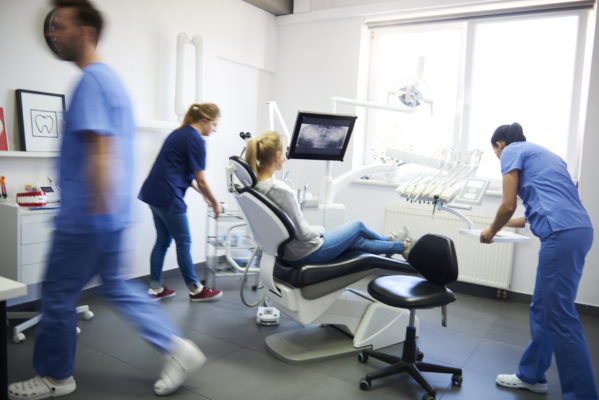Assessing Your Practice’s Staffing Needs Post COVID

As you begin the process of reopening your practice, you’ll soon realize that it will take more than simply welcoming back your dental office manager and accompanying crew to get things started. You’ll need to adjust to the new normal and consider what policies and procedures you’ll need to implement in order to keep yourself, your patients, and your staff safe. You’ll have plenty to consider, especially when it comes to your true staffing needs.
Unfortunately, despite what you may hope after losing the majority of your business for the last two months, production won’t ramp up to pre-shutdown levels right away. In fact, it will probably take some time before your production numbers even come close to what they were for the first two months of 2020.
Many patients remain nervous about the idea of visiting a dentist, or even their general practitioner, due to fears over COVID-19 exposure. Others who’ve lost their jobs, may no longer have insurance or will choose to wait until more financially stable before electing to receive what they may consider optional dental care.
To find success, you need to think about the new role your team members will take on going forward. The first step: Reassessing the size of your team and what duties you’ll need them to perform once your practice opens back up.
Identifying Your True Staffing Needs
For most practices, standard payroll sits somewhere between 20 and 25 percent of revenues. Having closed for a few months, that number is probably not where your practice resides currently. Anticipate payroll rising to above those numbers until you gain some idea of where your production and revenues will fall in the short term. Until you collect enough data to give you an idea of what you can forecast for the rest of the year, take some time to identify what areas of your practice can be improved.
To make that determination, trying asking some of the following questions:
- Do you need to staff at the same levels as before the pandemic?
- What role have shifted, and how may they have changed?
- Do new responsibilities need to be added to certain job descriptions?
- What performance measurements can you put into place to determine whether you’re meeting any stated goals?
Once you’ve gained an idea of what your true staffing needs are, consider the types of improvements team members can make that will help your practice recover more quickly.
Front Office
Your dental office manager’s day typically involves a mixture of patient related tasks (check-ins and payment collections) and non-patient tasks (billing, insurance processing, payroll). If a practice remains open for 8-hour days, or 480 minutes, your dental office manager should spend roughly 240 minutes on patient tasks and 240 on non-patient tasks. If you allow 10 minutes to both check-in and check-out a patient, one employee can successful deal with 24 patients a day. If your practice sees 16 patients a day, and you have two employees working the front desk, you’re likely going to go over that 20 to 25 percent payroll threshold.
For many dental practices, the challenge comes when the front office staff starts to feel overloaded when dealing with more than 24 patients a day. Important tasks don’t get completed, patients feel rushed or ignored, and the office suffers as a result.
Normally, at this point a dentist would elect to bring in additional help. Unfortunately, due to lost revenues and a decrease in patients as a result of COVID-19, that may not be a financially viable option.
One solution is to redefine the scope of some of your team’s job. As the number of patients goes up, consider opening up certain tasks and responsibilities among the entire staff. Consider having hygienists greet and check-in patients scheduled to receive a cleaning to free up time for your front office staff to complete other tasks. Try scheduling a little more time between appointments to give your front office staff time to catch up on other important tasks. Open the office up for a few hours on previous off-days to give staff the chance to complete billing and other paperwork related tasks.
A dental practice doesn’t need to have a clear delineation of tasks. Roles can open and duties reassigned until production levels rise to pre-COVID levels.
Dental Hygienist
Maintaining your budget requires ensuring that payroll expenses for dental hygienists don’t rise above 33 percent of their net production. When it goes above that number, the base you’re paying out becomes higher than the hygienist’s actual production.
Opening in the schedules greatly contribute to this issue, whether due to broken appointments or just a general decrease in appointment demand. If open appointment times have become a reoccurring issue, it’s likely due to the hygienist not being scheduled to meet production goals, a common sign that a problem exists within your scheduling system.
A failure to book appointments with returning patients months in advance, failure to follow up on appointment confirmations, a lack of patient education on the importance of receiving regular dental care, higher than average fees, and overly aggressive treatment options may be behind why your office has so many opening to fill.
Working with your hygienists on how to best meet their production goals can go a long way towards keeping payroll in line with revenues, and reducing the number of open appointment times on the calendar.
